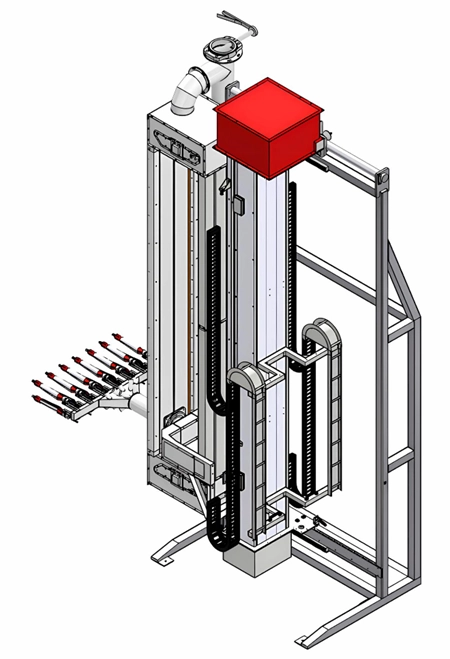Content Menu
● Understanding Spray Guns
>> Types of Spray Guns
>> Choosing the Right Spray Gun for Complex Shapes
>>> 1. Material Compatibility
>>> 2. Nozzle Size and Type
>>> 3. Spray Pattern Control
>>> 4. Weight and Ergonomics
>>> 5. Ease of Cleaning and Maintenance
● Techniques for Using Spray Guns on Complex Shapes
>> 1. Practice on Test Pieces
>> 2. Maintain a Consistent Distance
>> 3. Use Overlapping Strokes
>> 4. Adjust the Air Pressure
>> 5. Work in Sections
● Common Challenges and Solutions
>> 1. Uneven Coverage
>> 2. Drips and Runs
>> 3. Overspray
>> 4. Clogged Nozzles
● Maintenance Tips for Spray Guns
>> 1. Regular Cleaning
>> 2. Inspect for Wear and Tear
>> 3. Store Properly
>> 4. Follow Manufacturer Guidelines
● Conclusion
>> Frequently Asked Questions
When it comes to finishing complex-shaped workpieces, the choice of spray gun unit can significantly impact the quality of the finish and the efficiency of the application process. This article explores the various types of spray guns available, their features, and how to select the ideal unit for intricate projects. We will also discuss the importance of technique, material compatibility, and maintenance to ensure optimal performance.

Understanding Spray Guns
Spray guns are essential tools in various industries, including automotive, woodworking, and manufacturing. They are designed to apply coatings, paints, and finishes evenly across surfaces. The right spray gun can make a significant difference, especially when dealing with complex shapes that require precision and control.
Types of Spray Guns
There are several types of spray guns, each suited for different applications and materials. The main types include:
- Conventional Spray Guns: These use compressed air to atomize the paint, providing a fine mist. They are versatile but can be less efficient in terms of material usage.
- HVLP (High Volume Low Pressure) Spray Guns: These guns operate at lower pressure, reducing overspray and improving transfer efficiency. They are ideal for detailed work and are commonly used in automotive refinishing.
- Airless Spray Guns: These do not use compressed air; instead, they rely on a high-pressure pump to atomize the paint. They are suitable for larger surfaces and thicker materials but may not provide the precision needed for intricate shapes.
- Electrostatic Spray Guns: These guns charge the paint particles, allowing them to be attracted to the workpiece. This technology is highly efficient and reduces overspray, making it ideal for complex shapes.
Choosing the Right Spray Gun for Complex Shapes
When selecting a spray gun for complex-shaped workpieces, several factors should be considered:
1. Material Compatibility
Different spray guns are designed for specific materials. For example, HVLP guns are excellent for water-based paints, while airless guns can handle thicker materials like latex. Ensure that the spray gun you choose is compatible with the type of coating you plan to use.
2. Nozzle Size and Type
The nozzle size affects the spray pattern and the amount of material applied. For complex shapes, a smaller nozzle may be necessary to achieve precision. Additionally, adjustable nozzles can provide versatility for different applications.
3. Spray Pattern Control
The ability to control the spray pattern is crucial for intricate work. Look for guns that offer adjustable fan patterns, allowing you to switch between wide and narrow sprays depending on the shape of the workpiece.
4. Weight and Ergonomics
A lightweight and ergonomic spray gun can reduce fatigue during extended use, especially when working on complex shapes that require multiple angles and positions. Consider the design and comfort of the gun before making a purchase.
5. Ease of Cleaning and Maintenance
Complex projects often require multiple coats and touch-ups. A spray gun that is easy to disassemble and clean will save time and ensure consistent performance. Look for models with fewer parts and those that are designed for quick maintenance.
Techniques for Using Spray Guns on Complex Shapes
Using a spray gun effectively on complex shapes requires skill and technique. Here are some tips to enhance your spraying process:
1. Practice on Test Pieces
Before working on the actual workpiece, practice on scrap material. This allows you to adjust the settings and get a feel for the spray pattern and coverage.
2. Maintain a Consistent Distance
Keep a consistent distance between the spray gun and the workpiece. This distance can vary depending on the type of gun and material, but generally, 6 to 12 inches is a good range. Maintaining this distance helps achieve an even coat.
3. Use Overlapping Strokes
When spraying, use overlapping strokes to ensure even coverage. This technique helps prevent streaks and missed spots, especially on complex shapes with curves and angles.
4. Adjust the Air Pressure
For HVLP and conventional spray guns, adjusting the air pressure can significantly affect the finish. Lower pressure reduces overspray, while higher pressure can help with atomization. Experiment to find the optimal setting for your specific project.
5. Work in Sections
For larger or more complex pieces, work in sections. This approach allows you to focus on one area at a time, ensuring thorough coverage and reducing the risk of runs or drips.
Common Challenges and Solutions
Spraying complex shapes can present unique challenges. Here are some common issues and how to address them:
1. Uneven Coverage
Uneven coverage can occur due to inconsistent distance, improper technique, or incorrect settings. To resolve this, ensure you maintain a steady hand and consistent distance, and adjust the spray pattern as needed.
2. Drips and Runs
Drips and runs are often caused by applying too much material in one area. To prevent this, use lighter coats and allow each layer to dry before applying additional coats.
3. Overspray
Overspray can waste material and create a mess. To minimize overspray, use an HVLP spray gun, adjust the air pressure, and practice proper technique.
4. Clogged Nozzles
Clogged nozzles can disrupt the spray pattern and lead to poor finishes. Regular cleaning and maintenance are essential. Always clean the gun immediately after use and follow the manufacturer's instructions for disassembly and cleaning.
Maintenance Tips for Spray Guns
Proper maintenance of your spray gun is crucial for longevity and performance. Here are some essential maintenance tips:
1. Regular Cleaning
After each use, disassemble the spray gun and clean all parts thoroughly. Use the appropriate cleaning solution for the type of paint used.
2. Inspect for Wear and Tear
Regularly check the nozzle, needle, and other components for signs of wear. Replace any damaged parts to maintain optimal performance.
3. Store Properly
Store your spray gun in a clean, dry place. Use a protective case if possible to prevent damage.
4. Follow Manufacturer Guidelines
Always refer to the manufacturer's guidelines for specific maintenance and cleaning instructions. This ensures that you are using the spray gun correctly and prolonging its lifespan.

Conclusion
Choosing the right spray gun unit for complex-shaped workpieces is essential for achieving a high-quality finish. By understanding the different types of spray guns, their features, and the techniques required for effective use, you can enhance your spraying skills and ensure successful outcomes in your projects. Remember to consider material compatibility, nozzle size, and ergonomics when making your selection, and always prioritize maintenance to keep your equipment in top condition.
Frequently Asked Questions
1. What type of spray gun is best for automotive painting?
- HVLP spray guns are generally preferred for automotive painting due to their efficiency and ability to produce a fine finish.
2. Can I use an airless spray gun for detailed work?
- While airless spray guns are great for large surfaces, they may not provide the precision needed for detailed work. HVLP guns are better suited for intricate applications.
3. How do I prevent overspray when using a spray gun?
- To minimize overspray, use an HVLP spray gun, adjust the air pressure, and practice proper spraying techniques.
4. What should I do if my spray gun nozzle gets clogged?
- If the nozzle clogs, disassemble the gun and clean it thoroughly. Use the appropriate cleaning solution based on the type of paint used.
5. How often should I clean my spray gun?
- It is recommended to clean your spray gun after each use to maintain performance and prevent clogs.
Hot Tags: China, Global, OEM, private label, manufacturers, factory, suppliers, manufacturing company










































 .
. 